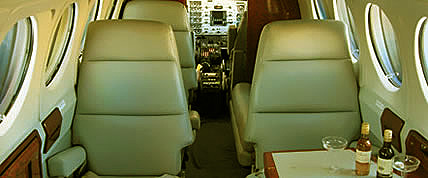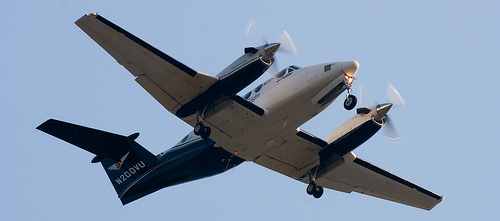
King Air is a twin-turboprop aircraft produced by the Beech Aircraft Corporation. The King Air line of aircraft includes a number of model series that fall into two lines: the Model 90 series, Model 100 series (these models comprising the King Air family), Model 200 series and Model 300 series. The latter two series were originally sold as the "Super King Air" family, but the "Super" was discontinued in 1996.
The Super King Air family has been continually produced since 1974, making it the longest production run of any civilian turboprop plane in its class. It has survived all of its competition and as of 2007 the only other aircraft in its class is the Piaggio Avanti. As of August 2008, the B200GT and the larger B300 are the production models. In addition, the Beechcraft 1900 was inspired by the King Air 200.
Model 200 Super King Air
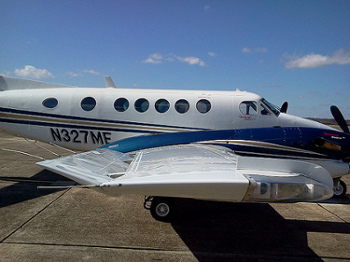 Originally designed as the Model 101 in 1969, the Model 200 was a
development of the Model 100 King Air. The Model 200 had virtually the
same fuselage as the Model 100, with alterations to the rear fuselage to
allow for a new T-tail and structural changes to provide higher maximum
pressurisation. Besides the T-tail, other changes included Pratt &
Whitney Canada PT6A-41 engines rated at 850 shp instead of the 680 shp
engines of the Model A100 that were in production at the time, and
increased wing span and additional fuel capacity. Overall, the 200 was 3
ft 10 in (1.17 m) longer than the A100, with wingspan 4 ft 3 in (1.29 m)
greater, containing 60 US gallons (230 l) more fuel. Maximum Take-Off
Weight (MTOW) was increased by 1,000 lb (450 kg). After ongoing
development which included extensive wind tunnel testing of the design
(especially of the T-tail which was tunnel-tested for 375 hours), the
prototype premiered for the first time on 27 October 1972; a second
prototype flew for the first time December 15, later the same year. In
1972, three production planes were also manufactured and delivered to
the US Army; these three were named Model A100-1s by Beechcraft and were
given the military designation RU-21J; the first of some 400 T-tail King
Airs to be ordered by the US armed forces. The 200 was granted civil
certification in December 1973 and the first civil delivery began in
February 1974.
Originally designed as the Model 101 in 1969, the Model 200 was a
development of the Model 100 King Air. The Model 200 had virtually the
same fuselage as the Model 100, with alterations to the rear fuselage to
allow for a new T-tail and structural changes to provide higher maximum
pressurisation. Besides the T-tail, other changes included Pratt &
Whitney Canada PT6A-41 engines rated at 850 shp instead of the 680 shp
engines of the Model A100 that were in production at the time, and
increased wing span and additional fuel capacity. Overall, the 200 was 3
ft 10 in (1.17 m) longer than the A100, with wingspan 4 ft 3 in (1.29 m)
greater, containing 60 US gallons (230 l) more fuel. Maximum Take-Off
Weight (MTOW) was increased by 1,000 lb (450 kg). After ongoing
development which included extensive wind tunnel testing of the design
(especially of the T-tail which was tunnel-tested for 375 hours), the
prototype premiered for the first time on 27 October 1972; a second
prototype flew for the first time December 15, later the same year. In
1972, three production planes were also manufactured and delivered to
the US Army; these three were named Model A100-1s by Beechcraft and were
given the military designation RU-21J; the first of some 400 T-tail King
Airs to be ordered by the US armed forces. The 200 was granted civil
certification in December 1973 and the first civil delivery began in
February 1974.
In 1976 Beechcraft conceived the Model 200T, a version designed for aerial surveying or reconnaissance. The prototype was produced by modifying a Model 200 aircraft. The changes included alterations to the belly aft of the wing to enable photography with a vertical camera, capacity for a pod housed, surveillance radar under the fuselage, dome-shaped windows on the sides of the rear fuselage to facilitate observation directly below the aircraft, and a 50 US gallon (170 litre) useable capacity fuel tank on each wingtip to improve the aircraft's range. Customers could specify any combination of these improvements when ordering a 200T; all 200Ts were Model 200s modified at the factory and given new constructor's numbers.
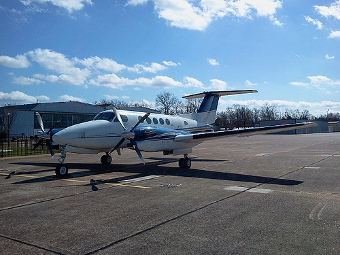 In 1979, the next model to debut was the Model 200C; this version had a
large cargo door on the LH side of the rear fuselage with an airstair
door built into it, similar to the Model 200's. The door opening was 4
ft 4 in (1.33 m) high and 4 ft 4 in (1.33 m) wide, allowing a wide range
of items to be loaded on board. The Model 200C gained popularity with
many operators who modified them internally as Air Ambulances. The 200C
was built from scratch rather than as a modification of the Model 200.
The Model A200C military version was developed concurrently. In 1981 a
Model 200C (c/no. BL-24) was modified as the Model 200CT, fitted with
the same wingtip fuel tanks as installed on Model 200Ts; there was only
one 200CT, but it led to other aircraft after an updated version of the
Model 200 entered production.
In 1979, the next model to debut was the Model 200C; this version had a
large cargo door on the LH side of the rear fuselage with an airstair
door built into it, similar to the Model 200's. The door opening was 4
ft 4 in (1.33 m) high and 4 ft 4 in (1.33 m) wide, allowing a wide range
of items to be loaded on board. The Model 200C gained popularity with
many operators who modified them internally as Air Ambulances. The 200C
was built from scratch rather than as a modification of the Model 200.
The Model A200C military version was developed concurrently. In 1981 a
Model 200C (c/no. BL-24) was modified as the Model 200CT, fitted with
the same wingtip fuel tanks as installed on Model 200Ts; there was only
one 200CT, but it led to other aircraft after an updated version of the
Model 200 entered production.
The updated and improved version was the Model B200, and entered production in 1981. Fitted with PT6A-42 engines, it was still rated at 850 shp but with improvements that granted improved aircraft performance. Other changes included increased maximum pressurisation (to 6.5 psi differential) and redesigns to the cockpit layout. The Model 200C gave way to the Model B200C the same year, with the first Model B200T and Model B200CT being modified from a B200 and B200C respectively the following year. Commencing in 1984 the B200, B200C and their offshoots were fitted with a new landing gear retraction mechanism, actuated by hydraulic rams powered by an electric pump installed in the LH wing. This replaced the earlier electro-mechanical retraction system of gearboxes, driveshafts and chains and sprockets that was a throwback to the Twin Bonanza. At the same time the propellers fitted were changed from 3-bladed Hartzells to 3-bladed McCauleys. 47 B200Cs built that year were delivered to the US military, with dozens more of a similar standard ordered in the following years but not given official civil model designations.
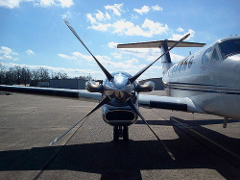 A total of 14 B200s were produced in 1989 and 1990 in a 13-seat high
density configuration with a belly cargo pod. These were marketed by
Beechcraft as a commuter airliner under the designation Model 1300. The
propeller installation changed again in 1992, when Beechcraft started
offering the option of having 4-bladed Hartzell or McCauley props, or
3-bladed Hartzell props; the 3-bladed McCauleys were no longer
available. Starting in October 1995 Beechcraft offered an updated B200
with Electronic Flight Instrument System (EFIS) avionics, this was
marketed as the "B200SE Super King Air" (for Special Edition). The
following year the "Super" name was dropped from all marketing and
advertising. In October 2003 Beechcraft announced another avionics
upgrade for the B200, the Rockwell Collins Proline 21 suite.
A total of 14 B200s were produced in 1989 and 1990 in a 13-seat high
density configuration with a belly cargo pod. These were marketed by
Beechcraft as a commuter airliner under the designation Model 1300. The
propeller installation changed again in 1992, when Beechcraft started
offering the option of having 4-bladed Hartzell or McCauley props, or
3-bladed Hartzell props; the 3-bladed McCauleys were no longer
available. Starting in October 1995 Beechcraft offered an updated B200
with Electronic Flight Instrument System (EFIS) avionics, this was
marketed as the "B200SE Super King Air" (for Special Edition). The
following year the "Super" name was dropped from all marketing and
advertising. In October 2003 Beechcraft announced another avionics
upgrade for the B200, the Rockwell Collins Proline 21 suite.
The B200 in production until the second half of 2007 and the B200C was on order up to that time, although no B200Cs had been built for nearly two years. On 21 May 2007, during the 7th Annual European Business Aviation Convention & Exhibition in Geneva, Hawker Beechcraft (as the company was now known) introduced the Model B200GT updated version of the B200. The B200GT is fitted with a new model of PT6 engine developed specifically for it by Pratt & Whitney Canada; while still rated at 850 shp the new PT6A-52 develops maximum power to an even higher altitude than the -42 it replaces, thus further improving aircraft performance. The B200GT and B200CGT with large cargo door were certified by the Federal Aviation Administration (FAA) on 16 November 2007 and by the end of the year 27 B200GTs had been delivered.
Hawker Beechcraft has elected to use new constructor's number prefixes for the B200GT and B200CGT; B200GTs are being built with the prefix "BY" and while no B200CGTs had been built as of August 2008, they will be delivered with the prefix "BZ".
General Info |
||
|---|---|---|
| Category | Turbo Prop | |
| Crew | 1/2 | |
| Passengers | 7, max 15 | |
| Top Speed | 290 kts | |
| Max Range | 1490 NM | |
| Power Plants | 200 - Two 635kW (850shp) Pratt & Whitney Canada PT6A41 turboprops driving three blade constant speed propellers. B200 - Two 635kW (850shp) P&WC PT6A42s. Fuel Type JetA | |
| URL | www.hawkerbeechcraft.com | |
Dimensions (External) |
||
| Wingspan | 16.61m | 54ft. 6in. |
| Wing area | 28.2m² | 304ft.² |
| Length | 13.36m | 43.8ft. |
| Height | 4.50m | 14.8ft. |
Dimensions (Internal) Cabin |
||
| Length | 5.1m | 16ft.8in. |
| Width | 1.4m | 4ft.6in. |
| Height | 1.5m | 4ft.9in. |
Baggage Capacity |
||
| Internal Volume | 1.5m³ | 54ft³ |
Weights |
||
| Max Ramp Weight | 5,710kgs. | 12,590lbs. |
| Max Takeoff Weight | 5,660kgs. | 12,500lbs. |
| Max Fuel Weight | 1,653kgs. | 3,645lbs. |
| Max Landing Weight | 5,660kgs. | 12,500lbs. |
| Basic Operating Weight | 3,878kgs. | 8,550lbs. |
| Max Payload | 839kgs. | 1,850lbs. |
| Useful Load | 1,791kgs. | 3,950lbs. |
Performance |
||
| Top Speed | 536km/h | 290kts |
| Cruise Speed | 504km/h | 272kts |
| Max Range | 2,760kms | 1,490nm |
| Max Operating Altitude | 10,022m | 32,880ft. |
| Take Off Field Length | 786m | 2,579ft. |
| Landing Field Length | 632 | 2,074ft. |
